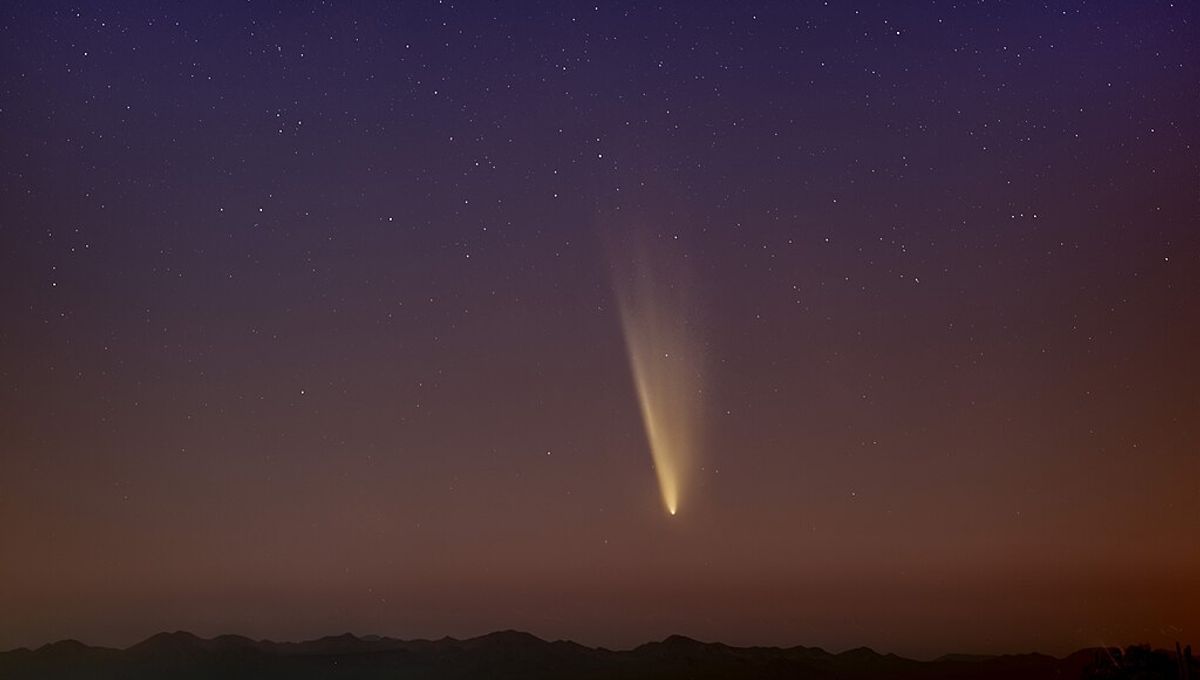
Comet C/2024 G3 (ATLAS) is expected to become brighter than Venus next week, and will probably be the brightest comet of 2025. It has already achieved a brightness similar to famously bright stars like Antares and Spica – however, that doesn’t mean it’s easy to see, nor will it become so.
Whereas Venus is currently putting on a show in the evening sky long after the Sun has set, Comet C/2024 G3 is a comet that will be very close to the Sun from our perspective when its brightness peaks, so the best chance to see it will be when it is further away, but also substantially fainter. Moreover, it will be best seen from the southern hemisphere, where fewer people live.
Comet C/2024 G3 is what is known as a “sungrazer” or “sunskirter”, a comet that gets close enough to the Sun to put itself at risk of breaking up entirely as all its ices turn to gas. In Comet C/2024 G3’s case, its orbit will take it more than ten times closer to the Sun than Earth ever gets, and four times closer than Mercury.
It has an extremely long, thin orbit – so long that it is thought to be 135,000 years since it was last in these parts. Changes to its orbit from planets’ gravity mean that it will be even longer before it returns; assuming it survives its dance with the Sun, that is. However, while 135,000 years is a long time, this still means C/2024 G3 survived a previous passage that was probably equally close, increasing the chances it will make it through this one.
Last year saw two comets that generated excitement, with predictions they could put on spectacular displays. However, while neither turned out to be complete fizzers as some visitors of recent years have been, most people trying to spot them were disappointed. The same may prove true of Comet C/2024 G3 (ATLAS), but so far it is running ahead of predictions, not behind.
Like stars, comets’ brightness is measured in magnitudes, with negative magnitudes brighter than positive ones. Venus has a magnitude of -4.9 at its best. Prior to its arrival, there were hopes that C/2023 A3 would peak at levels of -8, but in the end, the brightest measurement was -4. That would still have been a tremendous show had it been visible after dark, but sadly, at that point, the comet was only a few degrees from the Sun from our perspective.
Something very similar will happen with C/2024 G3 (ATLAS), but some differences may give some people a better chance of seeing it. One is that, while current projections vary, some have it peaking at -6.1 on January 13. That’s more than six times as bright as C/2023 A3 managed. It’s already reached first magnitude.
Comet C/2024 G3 (ATLAS) now close to mag 1.5. From T75 Chile on Jan 5.[image or embed]
— Terry Lovejoy (@cometguy.bsky.social) January 5, 2025 at 1:03 PM
Unfortunately, C/2024 G3 will also appear even closer to the Sun at its peak from our perspective than C/2023 A3 ever was, making viewing close to impossible at that point. Indeed, even now, its apparent distance from the Sun in the sky is 14 degrees and falling fast.
The best hope of seeing it is to hope it survives its encounter with the Sun and to try to catch it around January 20, give or take a few days, at which point its brightness will be well down from the peak but might be sufficient to see after Astronomical twilight.
The other significant thing about C/2024 G3 is that it is very much a southern object. It currently has a declination of 24 South – that means it passes almost overhead from locations like Johannesburg or São Paulo. On the other hand, it would be hard to see from somewhere like New York or London even if a handy eclipse blocked out the Sun,
C/2024 G3 is moving north, but not by much or for long. It will be back at similar latitudes by the time the best chance to see it comes. After that, it will head even further south, becoming almost impossible to spot for anyone in the Northern Hemisphere temperate zone. Call it karma for all the northern hemisphere-only meteor showers southerners have to read about and cannot see without crossing the equator.
A note for anyone trying to spot this, or any other, comet: Comets’ brightness is the sum of the light put out by the surrounding coma and the tail. Something spread out like this is always going to be more affected by skyglow than a point object like a star. Consequently, don’t assume that because the comet is far enough from the Sun that you could see a star of similar brightness, you’ll be able to see it. The same goes for trying to find it in a light-polluted city once it has moved well away from the Sun, but also faded.
Source Link: Bright "Sun-Grazer" Comet C/2024 G3 (ATLAS) Could Be Brighter Than Venus Next Week